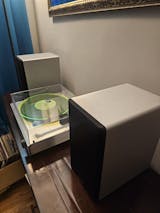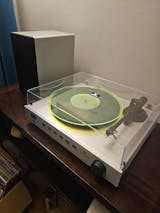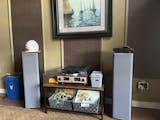How Does a Vinyl Record Work: A Simple Step-by-Step Guide
No doubt, vinyl records are an awesome piece of history because they have the associated coolness of being a vintage item. Despite the fact that we live in a digital world, old-school vinyl records will never be old-fashioned. Listening to a record player is really an enjoyable experience. Many people wonder how does a vinyl record player works? Sure, there is a real scientific explanation on how it works, so find out more about vinyl records, their history, and how they produce sound.
History of Vinyl Records
Before discussing how does a vinyl record player work, you must know what year did the record player come out, what is an old record player called, and who invented it, because it’s a must-have knowledge, especially for vinyl record lovers.

It’s a reality that nowadays, we take music reproducing for granted. Thomas Edison invented the first device which could record and produce sound in 1877. Before Edison, different inventors created devices that could record sounds, but those devices could not reproduce sound. It was Thomas Edison who created a device that could perform both recordings and reproducing the music. This device was not a vinyl record but the cylinder which was played on a phonograph which is also known as a record player, an instrument that reproduces sound with the help of a needle following a groove on a rotating disc. In a short time, these cylinders were replaced by records with the invention of the phonograph record disc by Emile Berliner. These flat discs also faced limitations as they were hard to mass produce due to the spiral groove running from the edges towards the center. So, these discs further evolved, and the real revolution happened in 1948 when the very first vinyl records were introduced. The main advantage of these records was the easy mass production which allowed produced to sell hundreds of copies.
Not only Records but record players also evolved alongside from a phonograph and gramophone to a turntable. Basically, these turntables use a cartridge system along with a stylus which is technically known as a transducer. It converts mechanical energy into sound waves, which are further amplified and broadcast through speakers.
How Does a Vinyl Record Player Work
Now you know about the history of vinyl records, let’s find out how a record player rotates and reproduces sound.
1.Rotation of the Platter
The first which starts the process of reproducing sound is the motor which is the heart of every record player. It pulls the belt by creating a movement and rotates the platter. The record is held by the spindle, which protrudes from the center. In order to avoid audible noise or any other disturbing noise, the motor maintains a consistent and smooth speed which is picked up by the needle.
Record player motors are available in both AC and DC. Both of these styles are made using a combination of bearings and magnets, and the efficiency of the motor totally depends on the quality and functionality of these parts. Talking about the most economic option, the AC motors are relatively less expensive, however, DC motors are quieter. So, to experience minimal noise, prefer a record player with a DC motor having a stable platter.
2.Stylus Captures the Music
When the record starts rotating, the stylus (needle) travels across the groove to capture the music written on the record. The accuracy of the sound reproduced totally depends on the grade of the stylus. Styli are made from sapphire or diamond, and they come in various shapes. Finer shapes of the stylus improve fidelity by tracing the walls of the groove more closely.
For better performance, the alignment and tracking force of the cartridge must be adjusted appropriately. A properly adjusted cartridge allows the stylus to trace the groove smoothly, while a misaligned cartridge may cause distortion, skipping, and stylus wear. Moreover, excessive tracking force can ruin the grooves of your records.
Cartridges act as transducers that are responsible for converting mechanical energy into electrical energy. When the stylus vibrates against the groove walls, it causes the magnets to move back and forth near a coil. It is called a moving magnet cartridge. However, moving coil cartridges work in a different way which modulates the coil movement in a magnetic field.
3.Signal Amplification

The amplifier performs the last step. Firstly, a signal is sent to a preamp which ensures the compatibility of output level with your system. This is called the phono stage. This system is already built-in many advanced record players, however, some old models require an external preamp. After passing from the phono stage, the signal is finally sent to the speakers (or your headphones) after it has been amplified into sound by an amplifier from an electrical signal to sound. Speakers have a diaphragm that moves back and forth likewise stylus. The movement of the diaphragm causes the vibration of air particles, and this vibration reaches your eardrums creating the sound you hear.
The amplification of sound also depends on the setup of your speakers. No matter which type of system you use, experiencing a record player and listening to the music always gives you a rich and warm sound.
The record players have been in the market for over a century, and people still love them. Thomas Edison’s simple curiosity and Emile Berliner’s effort to pursue it to perfection led to discovering this fantastic and enjoyable way of listening to music. Nothing could stay as long as vinyl records maintained their place; other formats have come and gone but could not beat the coolness of vinyl records. The science behind how does a vinyl record work is also fascinating and surprise the listeners with a warm sound they hear. Undoubtedly, the history of vinyl records and how they evolved with time are colorful and full of new inventions. Through this evolution, vinyl records allowed their listeners to experience greater diversity in the type of music they can listen to. Now people have much more options to access various styles and varieties of sound. Moreover, records have also given musicians the opportunity to share their art, which ultimately helped the music industry grow and advance over time.
·2022s Angels Horn record player:
Angels Horn Store:

Bring music to life.
AngelsHorn Mission
AngelsHorn offers a variety of record players, each with an elegant, retro style designed to provide a high-quality music experience.
Our record players are decorative, functional, and environmentally friendly, a perfect combination of classic record players and modern audio technology. Choose the AngelsHorn record player to make your life more colorful!
AngelsHorn, Better Products, Better Service, Lower Prices!











Deixe um comentário